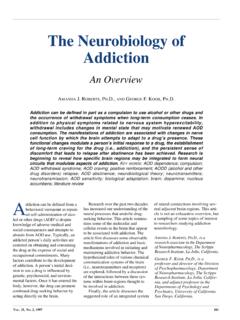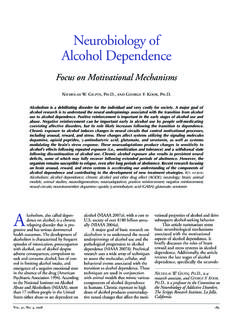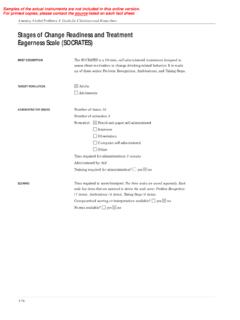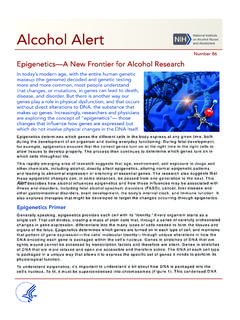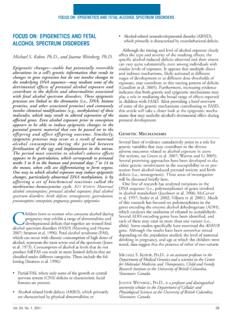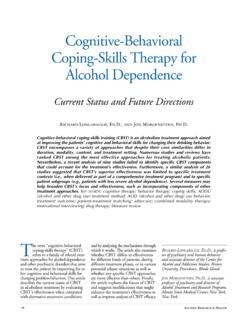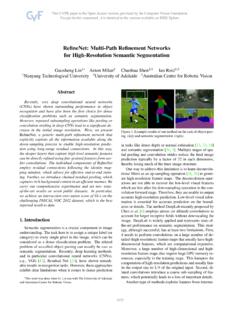Transcription of Overview: How Is Alcohol Metabolized by the Body?
1 Overview: How Is Alcohol Metabolized by the Body? Samir Zakhari, SAMIR ZAKHARI, , is director, Division of Metabolism and Health Effects, National Institute on Alcohol Abuse and Alcoholism, Bethesda, Maryland. Alcohol is eliminated from the body by various metabolic mechanisms. The primary enzymes involved are aldehyde dehydrogenase (ALDH), Alcohol dehydrogenase (ADH), cytochrome P450 (CYP2E1), and catalase. Variations in the genes for these enzymes have been found to influence Alcohol consumption, Alcohol -related tissue damage, and Alcohol dependence. The consequences of Alcohol metabolism include oxygen deficits ( , hypoxia) in the liver; interaction between Alcohol metabolism byproducts and other cell components, resulting in the formation of harmful compounds ( , adducts); formation of highly reactive oxygen-containing molecules ( , reactive oxygen species [ROS]) that can damage other cell components; changes in the ratio of NADH to NAD+ ( , the cell s redox state); tissue damage; fetal damage; impairment of other metabolic processes; cancer; and medication interactions.
2 Several issues related to Alcohol metabolism require further research. KEY WORDS: Ethanol-to acetaldehyde metabolism; Alcohol dehydrogenase (ADH); aldehyde dehydrogenase (ALDH); acetaldehyde; acetate; cytochrome P450 2E1 (CYP2E1); catalase; reactive oxygen species (ROS); blood Alcohol concentration (BAC); liver; stomach; brain; fetal Alcohol effects; genetics and heredity; ethnic group; hypoxia The effects of Alcohol ( , ethanol) on various tissues depend on its concentration in the blood (blood Alcohol concentration [BAC]) over time. BAC is determined by how quickly Alcohol is absorbed, distributed, Metabolized , and excreted.
3 After alco hol is swallowed, it is absorbed primar ily from the small intestine into the veins that collect blood from the stom-ach and bowels and from the portal vein, which leads to the liver. From there it is carried to the liver, where it is exposed to enzymes and Metabolized . The rate of the rise of BAC is influ enced by how quickly Alcohol is emp-tied from the stomach and the extent of metabolism during this first pass through the stomach and liver ( , first-pass metabolism [FPM]). BAC is influenced by environmen-tal factors (such as the rate of Alcohol drinking, the presence of food in the stomach, and the type of alcoholic bev erage) and genetic factors (variations in the principal Alcohol -metabolizing enzymes Alcohol dehydrogenase [ADH] and aldehyde dehydrogenase [ALDH2]).
4 The Alcohol elimination rate varies widely ( , three-fold) among individ-uals and is influenced by factors such as chronic Alcohol consumption, diet, age, smoking, and time of day (Bennion and Li 1976; Kopun and Propping 1977). The consequent deleterious effects caused by equivalent amounts of alco-hol also vary among individuals. Even after moderate Alcohol consumption, BAC can be considerable ( to gram-percent [g%]; in the 10- to 20-millimolar1 [mM] range). Alcoholreadily diffuses across membranes and distributes through all cells and tissues, and at these concentrations, it can acutelyaffect cell function by interacting with certain proteins and cell membranes.
5 As explained in this article, Alcohol metabolism also results in the genera tion of acetaldehyde, a highly reactive and toxic byproduct that may contribute to tissue damage, the formation ofdamaging molecules known as reactive oxygen species (ROS), and a change in the reduction oxidation (or redox) state of liver cells. Chronic Alcohol con-sumption and Alcohol metabolism are strongly linked to several pathological consequences and tissue the balance of Alcohol s removal and the accumulation of poten tially damaging metabolic byproducts, as well as how Alcohol metabolism affects other metabolic pathways, is essentialfor appreciating both the short-term and long-term effects of the body s response to Alcohol intake.
6 Alcohol Metabolism Although the liver is the main organ responsible for metabolizing ingested Alcohol , stomach ( , gastric) ADHhas been reported to contribute to FPM. The relative contribution of the stom ach and the liver to FPM, however, is controversial. Thus, whereas FPM is 1A millimole represents a concentration of 1/1,000 (onethousandth) molecular weight per liter (mol/L). Vol. 29, No. 4, 2006 245 attributed predominantly to the stom ach (Lim et al. 1993; Baraona 2000), other previous studies (Lee et al. 2006) stress the role of the liver. Human ADH3, which is present in the liver and stomach, metabolizes Alcohol poorly at physiological BACs ( , g% BAC [or <50 mM]) in the liver but may play an important role in FPM in the stomach, because gastric Alcohol concentrations can reach molar range during Alcohol consumption (Baraona et al.)
7 2001; Lee et al. 2003). However, Crabb (1997) pointed out the insuffi ciency of gastric ADH to account for FPM, so this remains unresolved. Alcohol also is Metabolized in nonliver ( , extrahepatic) tissues that do not contain ADH, such as the brain, by the enzymes cytochrome P450 and catalase (see below). In general, Alcohol meta bolism is achieved by both oxidative pathways, which either add oxygen or remove hydrogen (through pathways involving ADH, cytochrome P450, and catalase enzymes), and nonoxidative pathways. Oxidative Pathways As shown in Figure 1, ADH, cytochrome P450 2E1 (CYP2E1), and catalase all contribute to oxidative metabolism of ethanol. ADH.
8 The major pathway of oxidative metabolism of ethanol in the liver involves ADH (present in the fluid of the cell [ , cytosol]), an enzyme with many different variants ( , isozymes). Metabolism of ethanol with ADH pro duces acetaldehyde, a highly reactive and toxic byproduct that may con tribute to tissue damage and, possibly, the addictive process. As shown in Table 1, ADH constitutes a complex enzyme family, and, in humans, five classes have been categorized based on their kinetic and structural properties. At high concentrations, Alcohol is elim inated at a high rate because of the presence of enzyme systems with high activity levels (Km),2 such as class II ADH, 3-ADH (encoded by ADH4 and ADH1B genes, respectively) and CYP2E1 (Bosron et al.)
9 1993). This oxidation process involves an interme diate carrier of electrons, nicotinamide adenine dinucleotide (NAD+), which is reduced by two electrons to form NADH. As a result, Alcohol oxidation generates a highly reduced cytosolic environment in liver cells ( , hepato cytes). In other words, these reactions 2Km is a measurement used to describe the activity of an enzyme. It describes the concentration of the substance upon which an enzyme acts that permits half the maxi mal rate of reaction. Alcohol Research & Health 246 Figure 1 Oxidative pathways of Alcohol metabolism. The enzymes Alcohol dehydrogenase (ADH), cytochrome P450 2E1 (CYP2E1), and catalase all contribute to oxidative metabolism of Alcohol .
10 ADH, present in the fluid of the cell ( , cytosol), converts Alcohol ( , ethanol) to acetaldehyde. This reaction involves an intermediate carrier of electrons, +nicotinamide adenine dinucleotide (NAD ), which is reduced by two electrons to form NADH. Catalase, located in cell bodies called peroxisomes, requires hydrogen peroxide (H2O2) to oxidize Alcohol . CYP2E1, present predominantly in the cell s microsomes, assumes an important role in metabolizing ethanol to acetaldehyde at elevated ethanol concen trations. Acetaldehyde is Metabolized mainly by aldehyde dehydrogenase 2 (ALDH2) in the mitochondria to form acetate and NADH. ROS, reactive oxygen species.



